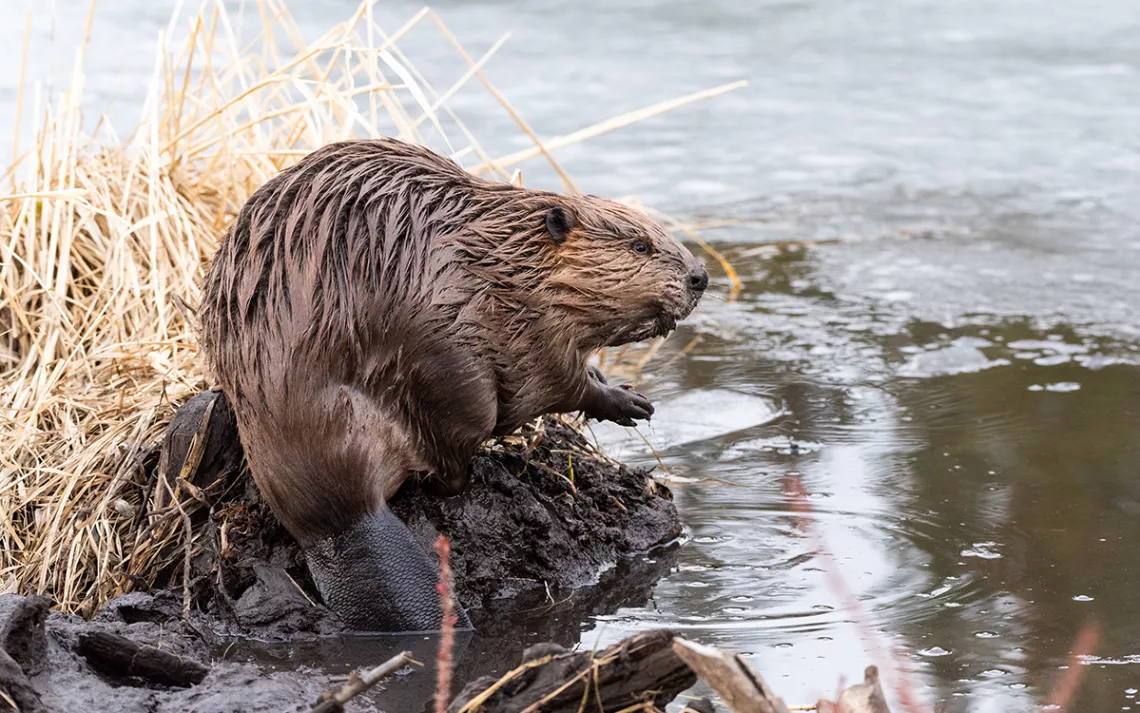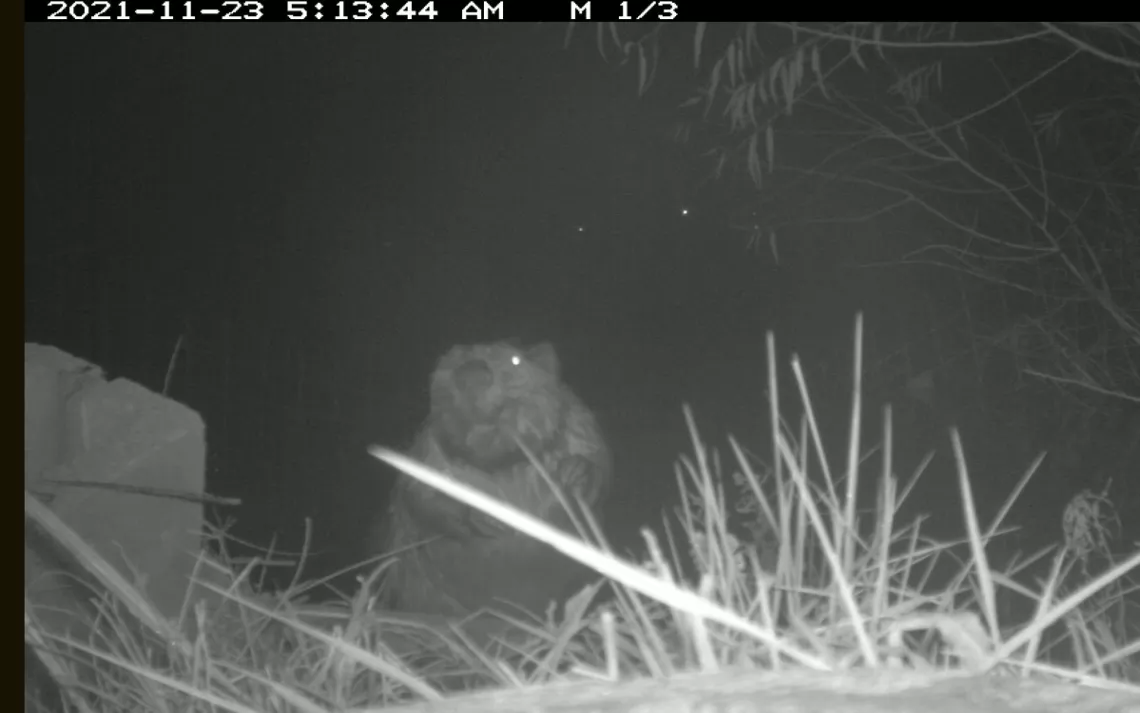We Don't Deserve Beavers
Meddlesome beavers are cleaning up Superfund sites

A young beaver crouches next to a dam. | Photo by Dan Pepper/iStock
Tar Creek doesn’t seem like an inviting home for wildlife. For more than 70 years, miners blasted open the earth underneath the Oklahoma waterway in search of lead and zinc. Today, mountains of waste material from the mines tower above what is now classified by the EPA as a Superfund site. Groundwater that flows through the abandoned mines flushes toxic heavy metals, including cadmium and lead—both potent neurotoxins even at low concentrations—into the creek. The water runs bright orange.
One family of toothy critters didn’t seem to care. In 2014, the beavers set up shop in a nearby tributary. “At first, they were a nuisance,” said Nick Shepherd, an environmental consultant and research assistant at the University of Oklahoma. At the time, Shepherd was conducting research at Tar Creek, and the beaver’s dam-building was messing with his data. “We couldn’t get measurements because the beavers had totally transformed the stream from a three-foot-wide channel to an 80-foot-wide meandering wetland,” Shepherd said.
Shepherd and his colleagues kept collecting data when they could. Then, two years after the beavers moved in, a team visiting the site noticed something interesting—the water that spilled over the beaver dams was running clear. Water-quality measurements seemed to confirm what they were seeing: just above one of the beaver dams, cadmium concentrations were 57 percent lower than they were upstream, where the polluted stream flowed into the beaver-created wetland, according to results they recently published in the journal Science of the Total Environment. Iron concentrations were 63 percent lower. The beavers were cleaning up Tar Creek.

A curious beaver cheesing for a wildlife camera left at the site. | Photo by Nick Shepherd
As many as 200 million beavers once felled trees and dammed North America’s waterways. But beginning in the 17th century, the fur trade wiped out close to 99 percent of the rodent’s population. The population is slowly rebounding. Today, there are around 15 million beavers in North America. Reintroductions are happening across the United States, from Washington to Wyoming. While Native people have long understood and respected the role of beavers in riparian ecosystems, some ecologists in the US are still coming around to the fact that beavers are a vital part of a healthy river system—and that they might be the key to buffering landscapes from the impacts of human activities and climate change, whether that’s agricultural pollution or wildfire.
Beavers build dams because they’re safer in the water. On land, with their unwieldy tails and awkward waddle, they make easy pickings for coyotes and bobcats. These beaver refuges flood the landscape around waterways, turning tiny tributaries into sprawling wetlands, flush with life. “When we have beavers, there's deep pools and shallow spots; fast water and slow water all mixed together,” said Emily Fairfax, an ecohydrologist at California State University Channel Islands. This variation in aquatic habitat not only creates habitat for a diversity of species, but it also supports a diversity of chemical processes—including those that can remove toxic contaminants from a Superfund site.
A stream without beaver dams “is like a firehose,” said Sarah Koenigsberg, a researcher and filmmaker at conservation nonprofit the Beaver Coalition. Water rushes through, pulling any contaminants along with it. But as water slows down above a beaver dam, it interfaces with the air above it and the groundwater seeping in from below. “You can just watch the chemical reactions happening in front of you as the stream is flowing,” said Rachel Gabor, a watershed hydrologist at the Ohio State University. At the ponds created by the beavers of the Tar Creek Superfund site, oxygen mixed and mingled into the water column. As it did so, it reacted with the iron turning the water orange and created ferrous oxide—rust. In its pure elemental form, iron dissolves into water, but rust forms heavy particulates, which sank to the bottom of the pond. Cadmium likes to bind onto rust, and so it too wound up at the bottom of the beaver pond.
In the study they published, Shepherd and his colleagues didn’t measure a difference in lead concentrations. However, the beaver dams might still work their magic with lead levels too. The mucky bottoms of beaver ponds create the perfect conditions for anaerobic bacteria, which thrive without oxygen. Instead, these microbes breathe sulfate, kickstarting a complex series of chemical reactions that eventually transform dissolved elemental lead into iron ore. Like rust, iron ore sinks to the bottom of beaver ponds. As the beavers continue to engineer the riparian ecosystem, Shepherd hopes that bacteria will pull lead and zinc out of the water. Right now, the beaver pond is young, so the bottom of the pond hasn’t yet developed into the thick sludge of a mature wetland." That happens with time, as plants and other organic matter sink to the bottom of the wetland and break down. “Right now, there isn’t much organic matter to create those anaerobic conditions,” Shepherd said. Plus, not much water makes its way through dense beaver-pond muck, which makes it a slow filter, Shepherd said. “But given a bigger wetland and more time, it’s possible.”
The Tar Creek beavers aren’t the only crew doing remediation work. At The Wilds, an Ohio site heavily polluted by coal mining, beavers succeeded in bringing dangerously acidic water, a common side-effect of mining, back to a healthy pH, Gabor said. It’s not entirely clear how the beavers are doing this, but Gabor thinks it has something to do with the interface between surface water and groundwater, which might dilute acidic surface water as it washes into the beaver-engineered wetland. That explanation doesn’t work for sites like Tar Creek, though, where groundwater is the source of pollution.
Beavers are doing us a favor by cleaning up these toxic sites. But doesn’t the pollution hurt them? “Would beavers prefer not to live in pollution? Sure!” Fairfax said. “But their habitat is really pinched, and they are going to build wherever they can. If they can live and thrive and create a colony in a polluted stream, they will.”
In the future, Shepherd and his colleagues plan to collect samples from the beavers from the Tar Creek site in order to analyze the heavy metal concentrations in their tissues. But the colony seems to be healthy and thriving; “It doesn’t seem to slow them down,” Shepherd said.
Introducing beavers to a toxic ecosystem would be an entirely different matter, Fairfax said. “If they don’t want to move in, it’s ethically questionable to put an animal into a known contamination site.” But, she said, scientists can get habitats ready for beavers by building human-made structures that resemble beaver dams, called beaver dam analogs (BDAs). These structures slow down water much like a beaver would, kickstarting the biochemical reactions that clean up waterways, and hopefully encouraging move in and take over the maintenance of those BDAs. “If beavers choose to come into those areas, that’s their prerogative as a creature that can make decisions,” Fairfax said. And who are we to object?
 The Magazine of The Sierra Club
The Magazine of The Sierra Club



